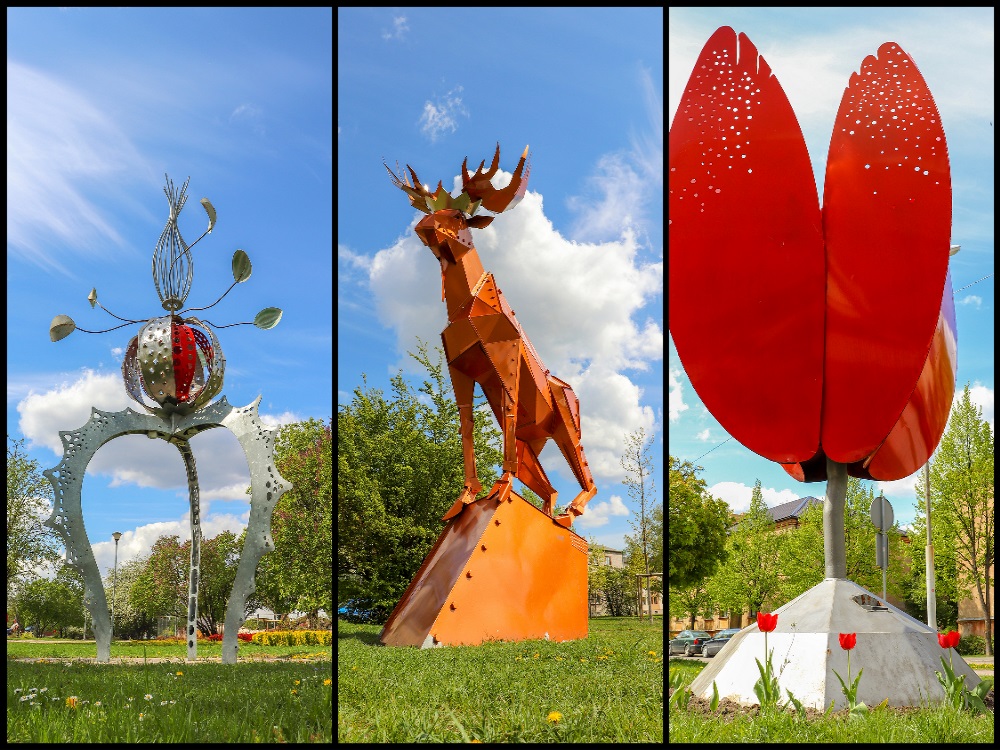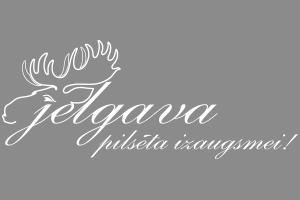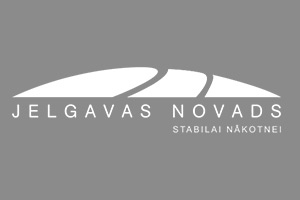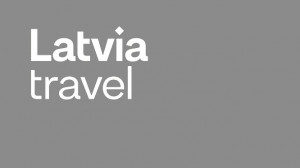1. Sculpture – fountain “Holy Trinity”
(Jānis Aivars Karlovs; 2010) the granite sculpture, split in three parts, symbolizes the core supreme values of the Christian faith – unity of the Father, the Son and the Holy Spirit (Holy Trinity Church tower)
2. Sculpture “Joker”
(Donāts Mockus; 2011) created with the purpose of conjuring a smile in the faces of city residents. At the first Metal Art Symposium in Jelgava “Second breath” it was given the Audience Sympathy Award. (Driksas street next to shopping centre “Pasāža”)
3. Sculpture “Teddy-bear”
(Nellija Skujeniece; 2015) it was initially installed in the Station park in the 1950s, when similar figures were placed all over Latvia. Today the sculpture has been restored and has regained its initial charm. (Station park)
4. Sculpture “Tulip”
(Gunārs Platpīrs; 2011) the sculpture was created as a park lamp – glowing tulip flower, which, according to the author, lights up the parks and gardens. The displayed flower resembles the famous hybrids, developed by the Latvian tulip growers. The sculpture has been made from recycled metal in Jelgava Metalworking factory (Competence development centre of Zemgale Region).
5. Sculpture “Fruktus Bumbūls”
(Gaitis Burvis; 2012) is 5.5 meter high and made from metal. It swirls in the wind and changes both in shape and colour, and glows during the night. The sculpture has been made within the framework of the Metal Arts Symposium. (Ozolskvērs)
6. Sculpture “Metal elk”
(Donāts Mockus, Inese Valtere; 2013) serves as a reminder of the symbol of Jelgava – the elk, which adorns the coat of arms of Jelgava. The elk is golden brown with pearl shine, and it wears a silver crown on the head, as displayed in the old coat of arms of the city. (Ozolskvērs).
7. Environmental object “Time train”
(Māris Gailis, Gundars Kozlovskis; 2019) In summer 2018 the grand oak in Oak Square (Ozolskvērs) was declared as greatly damaged and dangerous, therefore it was cut down and a 7 m tall sculpture was created from the oak within the framework of the Wood symposium “Second breath”, symbolizing the experience of the oak during 250 years. At the head of the sculpture there is a locomotive, which pulls three imitated wagons, displaying significant objects of Jelgava. (Ozolskvērs).
8. Environmental object “Time wheel 100”
(Kārlis Īle; 2018) dedication to the 100th anniversary of Latvia. Ten imitated images of people reflect those, who were involved in the creation and development of the Latvian nation. Many stones symbolize the years of existence of Latvia (Vecpilsēta street district)
9. Memorial note “Dobele gates”
(Ronalds Jaunzems; 2008) symbolic memorial note at the place of the historical city gates, displayed as iron gate pole with brick wall motive, which features an integrated stone with the message that in the 17th century Dobele city gates stood here. (intersection of Dobele and Vecpilsētas street)
10. Sculpture “Mix and put together”
(Kestutis Lanauskis; 2011) winning sculpture of the first Metal Arts Symposium. Was born as an idea of a small box of matches, which transforms into a moving lamp: it may be used for light, you can step on it and move its matches to play with the light. (Mātera street between Krišjāņa Barona and Dobele street)
11. Sculpture “Park flower”
(Māris Gailis, Armands Vecvanags; 2011) was made at the Metal Arts Symposium; it serves both as a luminary and a bench. (Victory Park)
12. Sculpture “Wind flower”
(Maija Puncule, Kristaps Krollis; 2011) was made at the Metal Arts Symposium, and it allows everyone to feel like an angel, as the petals are illuminated while you climb the stairs and the person gets wings of light. (Victory Park)
13. Sculpture “Waterfall”
(Algirdas Kuzma; 2011) was given Organizers’ Sympathy Award at the Metal Arts Symposium. The idea of the sculpture is to display the quick pace of today’s life, which resembles waterfall. You have to be a philosopher a little to understand it. (Victory Park)
14. Sculpture “I see you”
(Krists Zariņš; 2011) the sculpture was made at the Metal Arts Symposium; its idea is that people today have gotten so used to everything that they fail to notice so many interesting things that surround us. This time it concerns not only places, but also neighbours, who live next to us and observe us. They deserve attention, too. (Victory Park)
15. Sculpture “Silver tingling”
(Oskars Mikāns, Āris Smildzers; 2011) the sculpture was made at the Metal Arts Symposium. It is like a tree, which makes sounds in the wind; its main form of expression is tingling like wind chimes. (Victory Park)
16. Memorial note for the singer Nora Bumbiere
(Kārlis Īle; 2012) the sculpture combines two songs by the legendary singer, who lived in Jelgava – “Song of the last leaf” and “Deaf song”. The sculpture is lighted in darkness – its base glows red, causing associations with burning coal. (Square behind Jelgava Culture House)
17. Sculpture “Romantic type”
(Egons Peršēvics; 2011) the sculpture was made at the Metal Arts Symposium and was one of the most popular with visitors. It is made in the form of a lantern. (Jelgava Culture House)
18. Environmental object “Rain people”
(Kārlis Īle; 2008) the sculpture was made during the International Sculpture Quadrennial in Riga and was donated by the author to Jelgava city. It invites the visitor to stop, listen to his or her heartbeat and remember that water is the foundation of life. (intersection of Kronvalda and Lāčplēša streets)
19. Sculpture “Heartbird”
(Kārlis Īle; 2011) the sculpture was made at the first Metal Arts Symposium in Jelgava. Here is a small viewing area and benches – great place for meditation and meetings. (at the end of Lielupe promenade)
20. Chamotte sculpture park
comprises 13 large scale ceramic or chamotte sculptures, which were made at the Ceramic Symposium in 2015 and the Baltic Unity Days in 2018. They were created by talented Latvian and Lithuanian ceramists. (Pasta Island)
21. Wooden sculpture group “Baltic folk stories”
(Māris Gailis, Gundars Kozlovskis, Tautvils Poviļonis; 2018) was made within the framework of the Art festival “BALTS”. It is based on three horses – these images can be interpreted both as reference to three Baltic nations and as the dominant winds of the Baltic countries, each of which strives to own direction, creating a three point star, while at the same time approaching one goal. You may climb the horses and the sculpture also features swing elements. (Pasta Island)
22. Sculpture “Love trees”
(Aldis Sproģis; 2014) gift of SIA "Pils aptieka" to Jelgava – three Love trees made from metal, which were supplemented with two additional trees in 2018. Newlyweds attach locks to the trees on their wedding day as a symbol of locking their lives together. (Pasta Island)
23. Sculpture - fountain “Jelgava student”
(Kārlis Īle; 2013) is a diploma work of a sculptor, which he donated to the city of Jelgava. The artist gave “Jelgava student” the name of Jēkabs Ceriņš, who is a 3rd year student. The student’s umbrella handle possesses special powers – you have to make a wish and touch the handle, and it will come true. The student image is based on the student song lyrics: “The evening is late and it rains, a student wanders around Jelgava...” (at the base of Mītava Bridge)
Practical information:
Start and end of the route – at the Holy Trinity Church tower (Akadēmijas street 1)
Total length of the route ~ 15 km
The route can be taken by – bicycle*, or by foot
Route duration ~ 2 – 3 h
*Bicycle rent in Jelgava:
“KK workshop” (Lielā street 1, +371 29449717)




